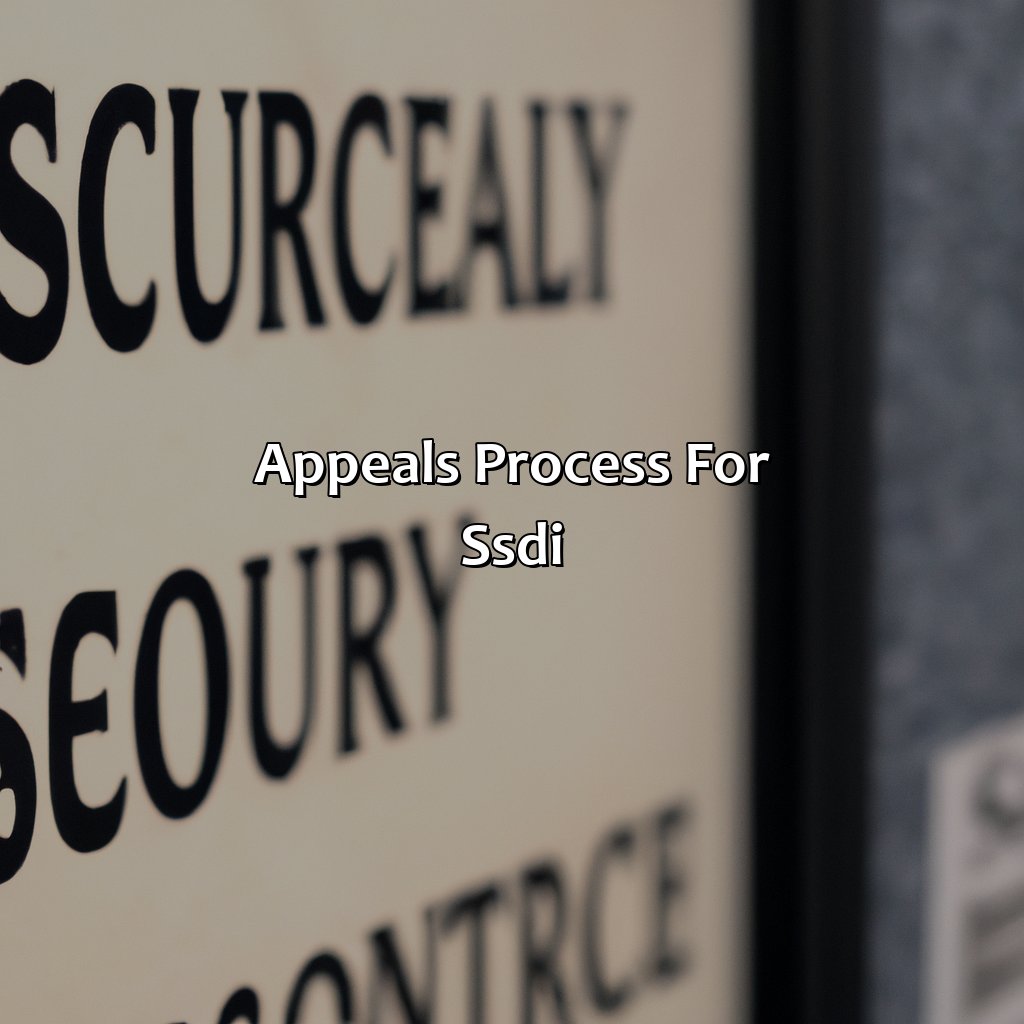How Does Social Security Disability Insurance Work?
Key Takeaway:
- SSDI is a federal insurance program that provides benefits to individuals who are unable to work due to a disability. To be eligible for SSDI, an individual must have worked a certain amount of time and paid Social Security taxes.
- The application process for SSDI can be lengthy and complex, but there are resources available to help individuals through the process. It is important to provide all necessary information and medical documentation to support the disability claim.
- The benefits of SSDI include monthly payments to help with living expenses, Medicare coverage, and work incentives programs that allow individuals to return to work without losing their benefits. However, the appeals process for SSDI can be challenging and may require legal assistance.
You’re concerned about what happens if you become disabled, and you need answers – fast. Get the facts about Social Security Disability Insurance (SSDI) so you can make informed decisions about your financial future. Discover how SSDI works and how to apply now.
Social Security Disability Insurance (SSDI)
To get a grip on SSDI and its requirements, you can look to this section! The first part looks at what you need to qualify. The second section explains the steps of the application process to get the benefits.

Image credits: retiregenz.com by Joel Jones
Eligibility criteria for SSDI
Social Security Disability Insurance (SSDI) requires specific conditions to qualify for benefits. One must have worked for an employer who paid Social Security taxes, earning at least 40 credits, twenty of which should be earned within the past ten years before the disability occurred. The applicant must also prove that their condition causes them significant functional limitations such that they cannot perform any substantial gainful activity (SGA). Mental or physical conditions which reduce earning capacity for twelve consecutive months or lead to death automatically qualify.
It’s worth noting that SSDI provides coverage for both temporary and permanent disabilities affecting a person’s ability to work substantially. Applicants are required to prove their medical records support impairment as well as its limiting function. In addition, some applicants may also be subjected to additional medical examinations before the certification process ends. When applying for SSDI benefits, it’s essential that one ensures relevant documentation is appropriately filled and provided in preparation for approval.
Pro Tip: Ensure you have all necessary documents giving legitimacy to your application before starting the whole process.
Getting approved for SSDI is like trying to win a game of Minesweeper blindfolded.
Application process for SSDI
The procedure to apply for Social Security Disability Insurance (SSDI) involves multiple steps that individuals must follow precisely. Here’s how to navigate the complex process in five easy steps:
- Start by collecting necessary data, including medical records, recent income statements, and other essential paperwork.
- Visit the SSA website or call your local Social Security office to start your claim process.
- Fill out the application form accurately and include all relevant information about your disability.
- Your case will be reviewed by a Disability Determination Services team member who may request additional documentation before making a final decision.
- Once approved, you will receive your first payment, either through direct deposit or mail.
It’s crucial to note that the processing time for SSDI claims varies significantly based on individual circumstances and the number of claims being processed at that time.
A helpful tip is to reach out for assistance from a qualified SSDI representative or someone who has gone through this process to ensure you don’t miss any critical details in your application. SSDI not only provides financial assistance, but also helps you gain the superpower of never having to worry about losing your income due to a disability.
Benefits of SSDI
Grasp the perks of social security disability insurance? Get the low-down on the monthly benefits, Medicare coverage, and work incentives programs. These benefits are tailored for people with disabilities. They help them keep a good quality of life.

Image credits: retiregenz.com by Harry Jones
Monthly benefits
For individuals enrolled in Social Security Disability Insurance, there are several monthly benefits available.
- First, SSDI beneficiaries receive a monthly payment based on their average earnings prior to becoming disabled.
- Additionally, eligible family members may also receive benefits.
- Lastly, qualified individuals may be eligible for healthcare coverage through Medicare after a 24-month waiting period.
It’s important to note that the maximum amount of SSDI benefits an individual can receive is subject to change each year due to cost-of-living adjustments.
To maximize your monthly benefits through SSDI, it’s recommended to stay up-to-date with any changes made by the Social Security Administration. Moreover, setting up direct deposit for payments and using a mySocialSecurity account can make applying for and managing benefits more convenient.
If only Medicare covered therapy for relatives who don’t believe in mental illness, we’d all be set.
Medicare coverage
Medicare benefits under SSDI
Individuals qualifying for Social Security Disability Insurance (SSDI) also qualify for Medicare coverage.
Medicare coverage offers medical insurance to eligible recipients and is divided into four parts- A, B, C, and D. Part A covers hospital visits while Part B covers outpatient services. In contrast, Part C and D cover alternate care options like prescription drugs or private insurance plans.
Notably, Medicare benefits may be delayed for two years following initial eligibility for SSDI. During this time, individuals may need to seek out alternative coverage options such as COBRA or Medicaid.
Missing out on Medicare coverage can lead to incomplete medical care and financial strain. Don’t let Medicare benefits fall by the wayside – seek out information about SSDI today.
Who said you can’t mix work and play? With work incentives programs, you’ll be earning money AND getting rewards, just like a participation trophy, but for adults.
Work incentives programs
Social Security Disability Insurance offers Work Incentives Programs to individuals with disabilities who want to return to work. These programs are designed to help them maintain financial stability and gradually ease back into the workforce. One such program is the Ticket to Work Program, which connects beneficiaries with employment services, vocational rehabilitation and training programs, and opportunities for self-employment.
Under Work Incentive Programs, recipients can continue receiving SSDI benefits while earning wages. Also, if their medical condition worsens or they’re unable to keep working due to their disability, they can easily sign up again for SSDI benefits without starting the application process all over again.
It’s essential to note that every beneficiary’s situation is different and that the alternatives may depend on each case. Another example of a work incentives program is the Plan for Achieving Self-Support (PASS). This program allows beneficiaries to set aside money in a designated account for expenses related to returning to work or starting a business while still qualifying for SSDI benefits.
One individual’s life changed after receiving SSDI benefits through these programs. A woman who’d sustained injuries in an accident was unsure of what her future held regarding work prospects because of her physical limitations. However, she learned about Ticket-to-Work via her local Social Security office and enrolled in a job-training program related to healthcare management. Her progress towards achieving employment goals kept her motivated as well; this new career path allowed her financial stability on top of less worry about future economic predicaments.
Why go to court when you can just appeal for SSDI and watch your bank account shrink in the meantime?
Appeals process for SSDI
The SSDI appeals process is a crucial step in obtaining disability benefits. After receiving a denial, applicants can request a reconsideration or hearing with an administrative law judge. It is important to gather sufficient medical evidence and accurately complete paperwork. After the hearing, a decision will be made and if necessary, further appeals can be made to the appeals council and federal court. It is important to follow the steps carefully and consider hiring an attorney for assistance.
To increase the chances of a successful appeal, applicants should focus on providing detailed medical documentation and maintaining consistent communication with the Social Security Administration. It is also important to fill out paperwork accurately and timely. Hiring an experienced attorney can help navigate the complex appeals process and present a strong case.
It is worth noting that the appeals process can be lengthy and stressful, but it provides the opportunity for applicants to receive benefits they deserve. It is important to stay patient and persistent throughout the process.

Image credits: retiregenz.com by Yuval Arnold
Five Facts About How Social Security Disability Insurance Works:
Social Security Disability Insurance (SSDI) is a federal program that provides financial assistance to individuals with disabilities who cannot work. (Source: Social Security Administration)
To qualify for SSDI, you must have a disability that prevents you from working and you must have earned enough work credits through paying Social Security taxes. (Source: AARP)
The amount of monthly SSDI benefits you receive is based on your past earnings and the length of time you worked before becoming disabled. (Source: Disability Benefits Center)
SSDI benefits can continue until you are able to return to work or until you reach your full retirement age, at which point you will transition to receiving Social Security retirement benefits. (Source: Disability Secrets)
You can apply for SSDI online, by phone, or in person at a Social Security office. (Source: The Balance)
FAQs about How Does Social Security Disability Insurance Work?
How does social security disability insurance work?
Social Security Disability Insurance (SSDI) is a federal program that provides financial assistance to individuals who are unable to work due to a disability. To qualify for SSDI, you must meet certain eligibility requirements and have paid into the program through payroll taxes. Once approved, you will receive a monthly benefit payment to help cover your living expenses.
What are the eligibility requirements for social security disability insurance?
To be eligible for SSDI, you must have worked in jobs covered by Social Security and earned enough work credits. You must also have a disabling condition that prevents you from working and is expected to last for at least 12 months or result in death. Additionally, you must be under the age of 65 and have not yet reached full retirement age.
How long does it take to get approved for social security disability insurance?
The time it takes to get approved for SSDI varies depending on a number of factors, including the complexity of your case, the amount of evidence you provide, and the workload of the Social Security Administration (SSA). On average, it can take anywhere from three to six months to receive a decision after you apply for SSDI.
How much money can you receive from social security disability insurance?
The amount of money you can receive from SSDI varies depending on your work history and the amount of money you paid into the Social Security system. The monthly benefit payment is based on your average lifetime earnings and can range from a few hundred dollars to over $2,000.
Can you work while receiving social security disability insurance?
If you are receiving SSDI benefits, you are allowed to work as long as your earnings do not exceed a certain amount. This amount changes each year and is referred to as the substantial gainful activity (SGA) threshold. In 2021, the SGA threshold is $1,310 per month for non-blind individuals and $2,190 per month for blind individuals.
What happens if your social security disability insurance application is denied?
If your SSDI application is denied, you have the right to file an appeal. The appeals process can be lengthy and may involve several levels of review, including a reconsideration, a hearing before an administrative law judge, and an appeal to the Social Security Appeals Council.
 Checkout this IRS Loophole
Checkout this IRS Loophole 
